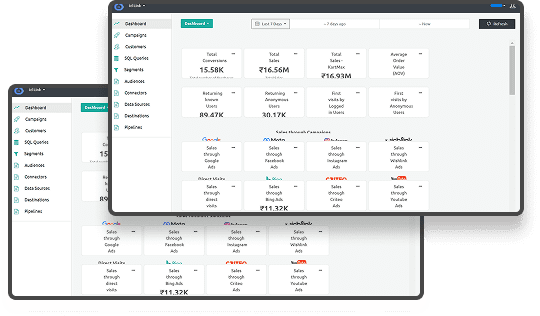What if you could predict exactly how much sales will increase with every dollar you spend on marketing? Media Mix Modeling turns this dream into a reality, helping businesses uncover the true value of their marketing investments.
Marketing success relies not just on creativity but also on data-driven decisions. Media Mix Modeling (MMM) is a proven approach that helps businesses measure the impact of various marketing channels on key outcomes like sales, conversions, or revenue. By analyzing historical data and applying advanced statistical techniques, MMM offers insights into which channels perform best and how to optimize budgets for maximum impact.
Understanding what works and what doesn’t is crucial in a world where marketing budgets are spread across numerous platforms, from traditional TV to digital ads. Media Mix Modeling empowers businesses to eliminate guesswork, reduce waste, and make confident decisions that lead to better results.
In this blog, we’ll explore Media Mix Modeling, its core elements, and its role in shaping effective marketing strategies.
What is Media Mix Modeling?
Media Mix Modeling (MMM) is a statistical technique that evaluates the impact of various marketing efforts on a business’s performance metrics, such as sales, revenue, or brand awareness. By analyzing historical data, MMM identifies how different media channels—like TV, radio, digital advertising, social media, and print—contribute to overall success. This analysis provides businesses with valuable insights to allocate their marketing budgets more effectively.
At its core, MMM quantifies the relationship between marketing investments and business outcomes by using advanced statistical methods like regression analysis. It isolates the impact of individual variables, such as ad spend, seasonality, or market trends, to determine how much each contributes to the company’s performance.
Core Elements of Media Mix Modeling
Media mix modeling includes several key parts that work together to give you a full picture of your marketing efforts. Knowing these elements is crucial for analyzing and improving your campaigns.
- Data Collection: The first step in media mix modeling is gathering accurate and complete data. This data comes from different marketing channels like digital ads, social media, email campaigns, and traditional media such as TV and radio. You also consider outside factors like seasonal trends and economic indicators to add context to your data. Using the best tools for tracking digital properties ensures you collect reliable information from all sources.
- Attribution: It’s important to figure out how each marketing channel contributes to your goals. Media mix modeling assigns value to each touchpoint, helping you see which channels drive conversions and which might need changes. Understanding different attribution models is key to making smart decisions. Additionally, exploring multi-touch attribution can give you deeper insights into how customers interact with multiple channels.
- Statistical Analysis: Advanced statistical methods are used to study the relationship between marketing activities and business outcomes. Techniques like regression analysis and time series analysis help find patterns and connections, allowing you to predict future performance and allocate resources better. Adding machine learning algorithms can make your predictions even more accurate.
- Optimization: The main goal is to improve your marketing mix based on the insights you gather. By moving your budget to the most effective channels, you can maximize your return on investment (ROI) and achieve better results overall. Tools like real-time data streaming let you make quick adjustments to your campaigns, ensuring continuous improvement.
Now that we’ve covered the core elements let’s look at the role of media mix modeling in your marketing strategy.
Media Mix Modeling’s Role in Marketing Strategy
Adding media mix modeling to your marketing strategy can change how you plan and run your campaigns. Here’s how it plays a key role:
- Informed Decision-Making: With data-driven insights, you can make smart choices about where to spend your marketing budget. This makes sure every dollar you spend helps achieve your business goals, improving overall efficiency. Using first-party data strategies strengthens your decisions by providing reliable and compliant data sources.
- Performance Measurement: Media mix modeling gives you a clear view of how each channel is performing. By tracking metrics like conversion funnels and UTM parameters, you can see how effective your campaigns are and make adjustments in real-time. Understanding click vs view conversions also helps you assess performance more accurately.
- Adaptability: The digital world is always changing, especially with the rise of a cookieless environment. Media mix modeling helps you stay flexible by adjusting your strategies to match changing market conditions and consumer behaviors. Implementing server-side tagging can improve your adaptability by offering more reliable data collection methods.
- Holistic View: By combining data from multiple channels, media mix modeling gives you a complete view of your marketing ecosystem. This broad perspective helps you find connections between channels and use them for greater impact. Using a customer data platform can further unify your data sources, giving you a better understanding of your customer journey.
With a good grasp of its role, let’s move on to the calculation and analysis techniques behind media mix modeling.
Calculation and Analysis Techniques
Effective media mix modeling relies on strong calculation and analysis methods to provide useful insights. Here’s a closer look at the techniques involved:
- Regression Analysis: This statistical method looks at the relationship between different variables. In media mix modeling, it helps determine how various marketing channels affect key performance indicators (KPIs) like sales or leads. Mastering regression analysis is essential for accurate modeling.
- Time Series Analysis: By examining data points collected over time, time series analysis finds trends, seasonal patterns, and cyclical behaviors. This is especially useful for forecasting future performance based on past data. Tools that support time series forecasting can boost your predictive abilities.
- Machine Learning Algorithms: Advanced machine learning techniques can handle large datasets and find complex patterns that traditional methods might miss. These algorithms improve the accuracy of predictions and provide deeper insights into consumer behavior. Adding machine learning can greatly enhance your analysis.
- Scenario Planning: This involves creating different hypothetical scenarios to see how changes in the marketing mix could affect outcomes. Scenario planning helps you test various strategies and choose the most effective one. Using scenario analysis tools can make this process easier.
- Attribution Modeling: As mentioned earlier, attribution modeling assigns value to each marketing touchpoint. By understanding which channels drive the most conversions, you can optimize your budget allocation. Exploring different attribution models provides a more complete view of your marketing effectiveness.
By mastering these techniques, you can fully utilize media mix modeling to drive your marketing success. Next, let’s explore the advantages this approach offers.
Advantages of Media Mix Modeling
Using media mix modeling in your marketing strategy comes with many benefits that can greatly improve your campaign performance:
- Enhanced ROI: By accurately identifying the most effective channels, you can spend your budget more wisely, ensuring a higher return on investment. Understanding return on ad spend (ROAS) is crucial for measuring and boosting your ROI.
- Data-Driven Insights: Media mix modeling offers actionable insights based on real data, reducing the need for guesswork and intuition in decision-making. This leads to more informed and strategic marketing efforts.
- Improved Campaign Performance: With a clear understanding of what works and what doesn’t, you can fine-tune your campaigns to achieve better results, such as more conversions and higher engagement rates. Using real-time analytics can further enhance your campaign performance.
- Strategic Budget Allocation: Media mix modeling helps you prioritize channels that perform best, allowing for more strategic and informed budget distribution. This ensures your marketing spend is directed towards the most impactful areas.
- Competitive Advantage: Using advanced analytics gives you an edge over competitors who might still rely on traditional or less sophisticated marketing strategies. Staying ahead with tools like programmatic advertising can strengthen your competitive position.
- Adaptability to Change: As market conditions and consumer behaviors change, media mix modeling lets you quickly adjust your strategies to stay effective. This flexibility is crucial in a dynamic marketing environment.
With these advantages in mind, it’s also important to understand the limitations and challenges of media mix modeling.
Limitations and Challenges
While media mix modeling offers significant benefits, it also comes with some challenges. Understanding these limitations can help you manage them better:
- Data Quality and Availability: Accurate modeling depends on having high-quality data. Incomplete or inaccurate data can lead to misleading insights and poor decisions. Ensuring data integrity is essential for reliable media mix modeling.
- Complexity: Media mix modeling uses sophisticated statistical techniques and requires a deep understanding of data analytics. This complexity can be a barrier for businesses without the necessary expertise or resources. Investing in training and tools can help overcome this challenge.
- Changing Market Dynamics: Rapid changes in the market, such as new technologies or shifting consumer preferences, can affect the accuracy of your models and require constant updates. Staying informed with market trend analysis is crucial to keep your models relevant.
- Integration Issues: Combining data from multiple sources and channels can be technically challenging, especially if your systems and tools aren’t well integrated.
- Time and Resource Intensive: Building and maintaining effective media mix models can take a lot of time and resources, which might be difficult for smaller organizations. Leveraging automation tools can help streamline the modeling process.
- Assumptions and Biases: Models are based on certain assumptions that might not always be true. Additionally, biases in data collection or analysis can skew results and affect decisions. Implementing bias mitigation strategies is important for keeping your models accurate.
Despite these challenges, the benefits of media mix modeling usually outweigh the drawbacks, especially when supported by strong tools like Ingest Labs. Let’s see how Ingest Labs can improve your media mix modeling efforts.
Ingest Labs' Role in Media Mix Modeling
Ingest Labs offers a range of tools designed to make your media mix modeling process easier and better. Here’s how our platform can support your marketing strategies:
- Ingest IQ: This platform efficiently collects, processes, and integrates data from various sources, including social media, customer databases, and website analytics. It provides real-time data insights, allowing marketers to monitor changes as they happen, and offers advanced visitor journey tracking to understand customer behavior.
- Cross-Channel Attribution: Ingest Labs' insights help marketers focus on the channels driving the most traffic and conversions. By complementing cross-channel attribution with MMM, Ingest Labs fills gaps where digital tracking falls short, providing a more comprehensive view of media efforts.
- Adaptation to a Cookieless World: With the shift towards privacy-first metrics and the decline of third-party cookies, Ingest Labs provides solutions that rely on privacy-first metrics, ensuring compliance while still offering insights into customer behavior. Their tools help marketers adopt new methods, such as contextual targeting and enhanced first-party data strategies, to maintain accuracy in audience targeting and campaign optimization.
Conclusion
Media mix modeling is a vital tool for optimizing your marketing strategies and maximizing ROI. By understanding the key elements, using advanced calculation and analysis techniques, and recognizing both the benefits and challenges, you can make informed decisions that move your business forward.
With Ingest Labs, you get access to a complete set of tools that make your media mix modeling efforts easier and better. From strong tag management and first-party data solutions to seamless integrations and real-time data streaming, Ingest Labs helps you handle the complexities of a cookieless environment with ease.
Ready to enhance your marketing strategy? Contact us today to learn how Ingest Labs can help you master media mix modeling and reach your business goals.






